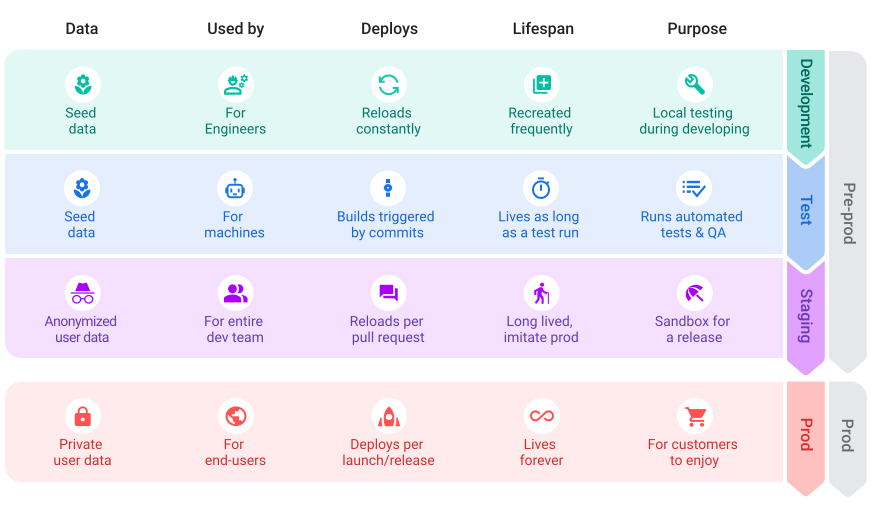For production apps, you need to set up a clear development workflow, especially if you have more than one person working on your app. A development workflow usually involves setting up and managing multiple environments.
Firebase has varying levels of support for developer workflows and the constituent environments. Once you're familiar with the developer workflow terms and assumptions on this page, check out our general best practices and general security guidelines for setting up a Firebase project and your apps.
About environments
In software development, an environment is all the hardware and software that are required to run an instance of an application or system of applications.
A series of environments provides isolation for developing and testing software without impacting users. As shown in the diagram below, environments at a high-level are considered either pre-production or production, and you can have as many pre-production environments as needed. The diagram also describes common practices and features associated with each type of environment.
The process of progressing a feature or release through these environments to production is called a deployment pipeline.

Types of environments
An environment is composed of the underlying infrastructure that you need to run and support your application, its code, and its data. Expand each of the following terms to review descriptions of some common environments, including tips on the types of data used in each environment type.
Every developer needs a development environment — a safe, isolated place to test changes as they're being built. Ideally, every developer on your team has access to their own dev environment. Also, if the dev environment is a local instance, a developer can iterate much faster.
The data in a dev environment is seeded with data that generally resembles the production data, but should never contain any real users' data. It may also contain data that has caused bugs in the past, like very long strings.
If you have automated tests, you need an environment in which to run those tests, and you need to reset the data each time you spin up the test environment.
If you have QA engineers, they may need one environment that they all use, or they may need individual environments to test a new release candidate.
The data in test and QA environments is seeded with quality data that's generally representative of the production data, along with data that represents corner cases and examples of data that have caused bugs in the past.
For realistic tests of how a release will work in production, you need a staging environment that mimics production infrastructure as closely as possible. It's common to have multiple staging instances if you need to test specific integrations in isolation.
Here are common differences between staging and prod:
Staging may be missing some features or integrations that could cause side effects. For example, staging may be set to not send email.
Staging may have anonymized data; the data can be fake, but it should be realistic. Because staging is a place to safely debug problems, you might give broader team access to staging data than production data. So, to protect user privacy, you shouldn't use actual user data in staging.
For each application that you maintain, you need a single production environment. This is the instance with which your users interact.
Unlike the other environments where you can change, delete, and/or recreate data, the data in your prod environment is very important; losing or altering your prod data will directly affect your users.
In the Firebase console, we recommend tagging the Firebase project associated with your production environment as a "production" environment type. This tag can help remind you and your teammates that any changes could affect your associated production apps and their data.
Next steps
Review our general best practices for setting up Firebase projects. This guide answers questions about Firebase project hierarchy, how to register your app variants, and multi-tenancy.
Review the general security guidelines for different environments. You want to make sure each environment and its data are secure.
Review the Firebase launch checklist.
